Permafrost: Flora, Fauna, and Ice
2020-04-23
OK, fine, I’m gonna talk about Flora and how it affects ice. And this is only partly because I’ve got pictures anyways and such. And my girlfriend is a genius at farming which is relevant here. Then ooh, Fauna, what’s this? Paleontology with Ice? Yeah boiiii. And this one has less math and chemistry! (Not that my introductory post had that much anyways
Section 1: Drunken Trees!
I’m gonna start off with these, because it’s the apocalypse and it’s time to driiinnnkk!!! Wait a sec, no, Alcohol suppresses your immune system. Stop drinking. Stop it, now.
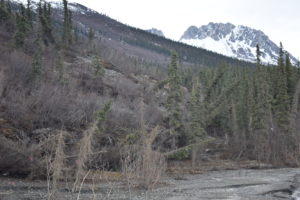
So what are drunken trees? Well, look at Figure 1.1. Why are these trees falling over? And why in Figure 1.2 does the tree next to me seem to be curving? Well, this one is pretty simple. As the permafrost melts, shifts, and refreezes underneath the trees, they start to tilt or fall over. Since this is just a small destabilization (not like a rapid mass wasting event that would rip the tree out of the soil), the tree can still survive and continue to grow. And since trees grow upwards, the top of the tree will actually turn and grow vertically again, leaving the kink. In some extreme cases like Figure 1.1, the Frozen Debris Lobe (Future topic) has bowled over these trees, but since the event happens slowly enough, many trees aren’t killed and continue to photosynthesize and grow.
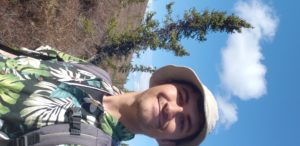
Section 2: Tussocks
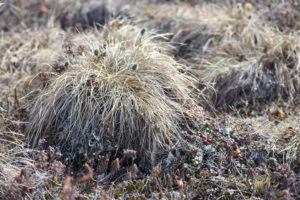
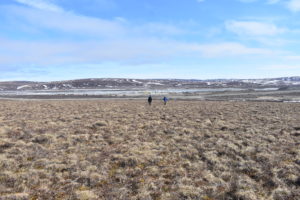
So if you’ve ever had the fortune to hike on the tundra north of the Brooks range in Alaska, you’ve had the misfortune of encountering these weird clumps of grass (Figure 2.1). Well, these are called tussocks, and in the Arctic, they’re composed from Cotton Grass or other sedges. They’re not quite stable, but you can’t just push your foot through them, so you’ll have to walk on top of them or between them, and either is a recipe for twisting your ankle. So how do these Arctic tussocks form? Well, first, you have a piece of cotton grass. When the frost comes, this weak piece of grass dies and is soon covered by snow, ignored until the thaw. When the thaw happens, the decomposition of the grass is slowed by the cold, but more Cotton Grass starts to grow in the same spot, as it’s easier to grow in a place where the tough frozen soil is already broken a little and they’re able to use the structure of the dead grass. Eventually, some of the grass is decomposed into soil and other plants start rooting into the tussock, further solidifying it.
Now, why is it harder for plants other than these shallow-rooted sedges to grow? Well, let’s look at Figure 2.2. So while Permafrost isn’t necessarily pure ice, this picture is really just demonstrative of how frozen the soil can be. All I did to get to the ice here was scrape away a cm or two of mud covering it. And, well, it can be hard to grow through ice.
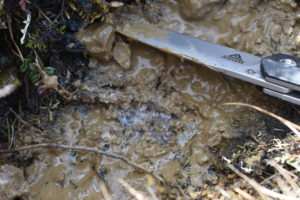
Section 3: The Arctic Tree Line
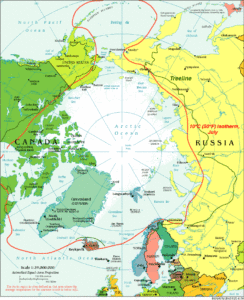
Now, why did my Figure’s from the last section have like, no trees? This is because of something called the Arctic Tree Line. Now, I normally try to draw my own figures or produce them from my photos, But I haven’t been to space and I’m too bad at drawing to do an accurate map, so here’s Figure 3.1, from the National Snow and Ice Data Center. Everything above the green line has no trees. Like none.
There are multiple reasons why, and it isn’t just permafrost. Though the permafrost doesn’t help, as the layers of frost prevent roots from forming deep. As a consequence, the only trees that can grow have shallow root systems, such as Black Spruces. The main problem is that the summer is quite short and much of the year doesn’t have enough sunlight to stimulate growth. Since the annual average temperature is low (Refer back to Figure 3.1, but this time to the red line. This is the isotherm (line where the average temperature is the same for a given period) where the hottest month is at 10°C, average hottest month temperatures north of that should be similar or lower), the trees only have a few days a year that it’s warm enough for photosynthesis to occur. This also means that some black spruce near the tree line might spend 100 years growing to a height easily achievable in a decade further south. Then, added on to this, you’ve got the cold arctic winds which will not only cause further damage to the trees, but will often, well, knock them over. For funsies, here’s a picture of me wearing definitely appropriate clothing for the environment just north of the tree line. [Figure 3.2]
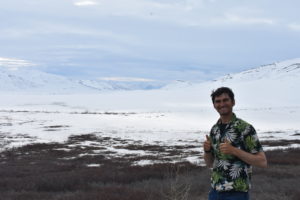
Section 4: Frozen Fruit
Now to jump to a couple non-permafrost things. First is Oranges. While some plants can survive a frost, Oranges can’t. So what farmers will do if the temperature is going to drop below the frost temperature, is they spray water all over their crops. At first glance this seems irrational, as you know, wouldn’t adding more things to freeze cause things to, ya know, freeze? Well, we have to go back to… ugh, Chemistry. So as I mentioned in the previous post, water doesn’t just pop to frozen as soon as it hits 0°C, it requires some sort of push and this push will have to release energy. Here we’ve got something called the Latent Heat of Fusion. And in order to freeze, the H2O has to give off some amount of heat. This heat will then be absorbed by the orange, keeping it enough above freezing, so the orange won’t be damaged.
Section 5: Frost Flowers
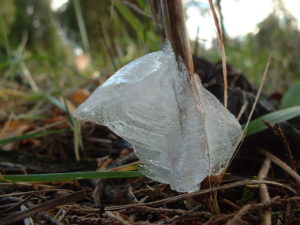
So I promised frost flowers. And here they are, Figure 5.1. Once again, I don’t have a photo of this, so here’s a picture from someone named Zotel in the Public Domain. I saw a bunch in Missouri when I lived there, but neglected to take pictures. In this, I’m just going to talk about the ones that come from plant stems, because I am not personally familiar with the other version. Plus the other version doesn’t, like, you know, involve flora. Or fauna.
So, back to what I was saying. Frost flowers can only occur in certain plants, require specific conditions, and will melt quickly. For a frost flower to form, there has to be liquid water in the stem of the plant, and the air outside has to be freezing. As water is pulled through the pores of the plant to the freezing surface, it pushes out any ice that’s formed while freezing itself, creating the ‘flower.’
And now a minor note you might be thinking about if you read the last post. Yes, the name is a bit of a misnomer, the ice forming here is not frost, it can often be found near frost though.
Section 6: Permafrost Paleontology
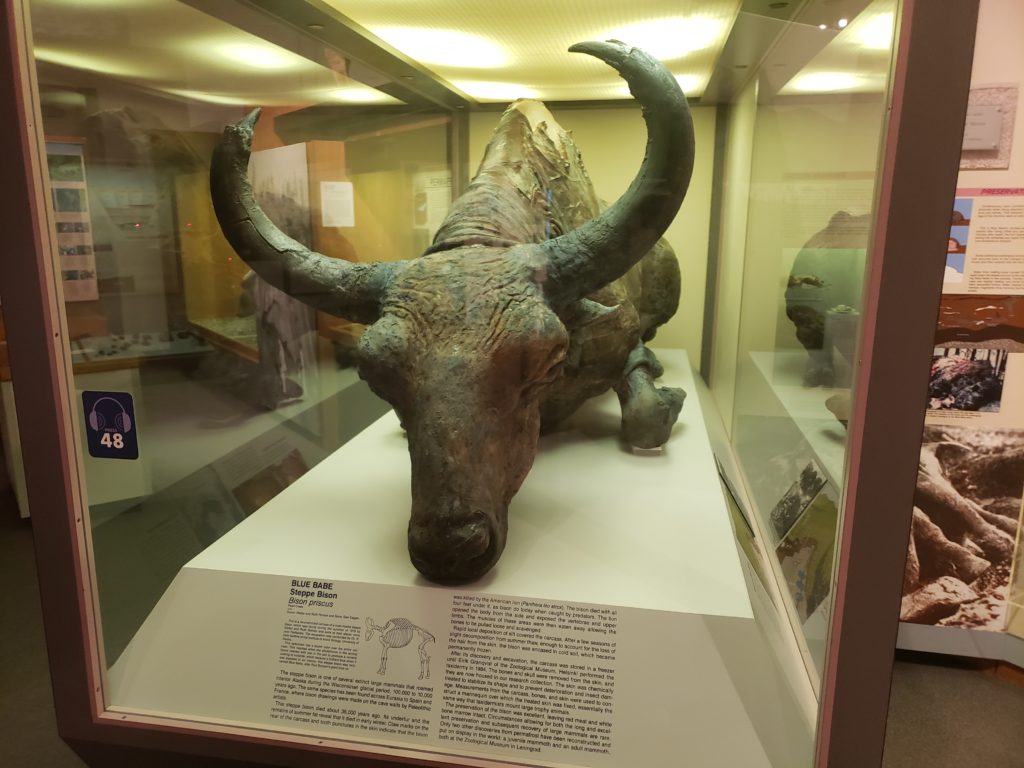
OK, I fully acknowledge I’m doing the thing clickbait articles do by leaving the most popular thing for last, but here’s how you can have paleontology with ice. So without further ado, meet Blue Babe (Figure 6.1). Blue Babe is a fossil of a Steppe Bison that lived and died 36,000 years ago north of present-day Fairbanks. He was found in the 70s by some hydraulic gold miners.
So since I’m interested in Economic Geology, I’m gonna tell what that means. Hydraulic mining is a form of placer mining (where you’re mining river sediment for your ore) where you use high-pressure water to blast apart the placer deposit and sluicing the material to find the ore. This mining technique isn’t used as much anymore because it can have direct environmental consequences for anyone downstream.
Back to Blue Babe. These miners were blasting the permafrost with their hoses when a carcass started to emerge. The miners quickly realized that anything frozen at this level of the permafrost was truly ancient, so they called scientists at the University of Alaska who excavated Blue Babe, finding a mostly intact, unlithified body. It had likely died in the fall or winter and frozen before scavengers managed to consume it. The body is so intact that the scientists were able to learn that Blue Babe had been killed by an American Lion. And not only could scientists tell what killed it, but lead Paleontologist Dale Guthrie was able to use some of the neck meat to prepare a stew for the other members of the team.
So now that I’ve said a bunch of things that haven’t changed, here’s one of the real notable things that has changed in the 36,000 years. The skin is blue! And no it isn’t because it’s cold or something. It’s because of a mineral called vivianite, which is an iron phosphorus. It formed when the phosphorus in Blue Babe’s skin reacted with iron in the soil. Vivianite isn’t blue on formation though, and in fact, it is white until exposed to air and oxidized, turning it the vivid blue color.
Section 7: End
As always, correct me if I’m wrong. And, you know, stay safe out there. Or I guess, inside. Stay indoors. Unless you’re reading this like after now and public health officials have lifted quarantines.
Thank you for Reading,
Daniel
Recent Comments